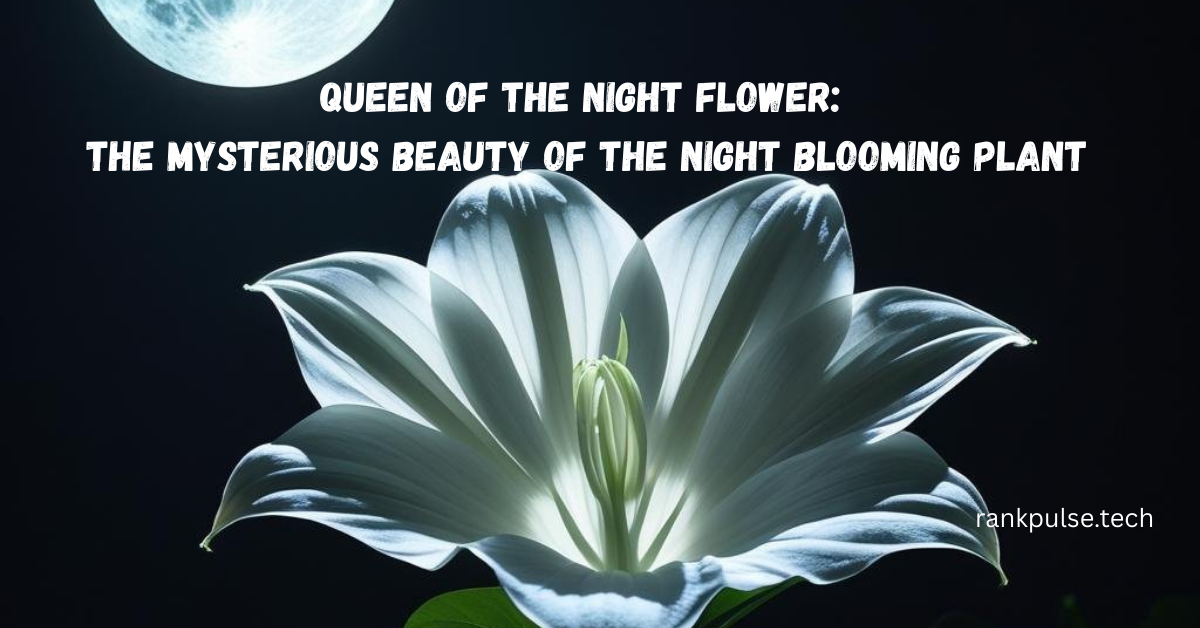Queen of the Night Flower: The Mysterious Beauty of the Night Blooming Plant
The Queen of the Night flower is one of the most breathtaking blooms in the world. Known as a night-blooming cereus or rare cactus flower, it captures attention because of its midnight bloom. This exotic garden plant is treasured for its fragrance and its unique ability to blossom only once a season. The mystical bloom has made it a popular symbol in poetry, spirituality, and exotic landscaping.
What is the Queen of the Night Flower?
Botanical Classification
Scientifically named Epiphyllum oxypetalum, this night flowering cactus belongs to the Cactaceae family. Unlike most desert cacti, its stems are flat and leaf-like, giving it an orchid cactus appearance. Its flowers can grow up to 10 inches wide, glowing like a moonlight flower.
Common Names Around the World
This plant is admired worldwide. In India, it’s called Brahma Kamal (though technically a different plant). In China, it’s Tan Hua. In the West, it’s known as the Dutchman’s Pipe Cactus. These diverse names show its universal appeal.
History and Origins of the Queen of the Night Flower
Cultural Significance in Different Regions
The Queen of the Night flower has been admired in ancient cultures. In India, it is considered sacred; in Japan and China, it is a good luck plant; and in Mexico, it was once called the flower of the gods by the Aztecs.
Legends and Symbolism
Folklore describes it as a symbol of fleeting beauty. Writers often use it to describe rare love or the spiritual flower of transformation.
Unique Blooming Behavior
Why It Blooms at Night
The midnight blooming cactus has evolved to open its petals after sunset to attract nocturnal pollinators such as moths and bats. Its fragrant night flower scent spreads strongly in the dark, guiding pollinators toward it.
How Long the Bloom Lasts
The bloom begins in the evening, reaches full beauty by midnight, and fades before sunrise. Its life is short but memorable, making it one of the most rare summer flowers in nature.
Physical Characteristics of the Flower
The Queen of the Night Flower is known for:
- Size: Large blossoms up to 8–10 inches.
- Color: Pure white petals glowing in moonlight.
- Scent: An intoxicating fragrance that fills gardens at night.
This giant cactus bloom often becomes the centerpiece in tropical gardens.
Different Types of Night Blooming Cereus
- Epiphyllum oxypetalum – the most common type grown in homes.
- Selenicereus grandiflorus – known as the “Large-Flowered Night Cactus.”
- Rare Hybrids – collected by plant lovers for their unique traits.
These orchid cactus varieties are prized for their one-night-only floral shows.
Ideal Growing Conditions
The Queen of the Night thrives in tropical cactus care environments. It prefers warm climates, indirect light, and well-draining soil. When grown indoors, it flourishes in semi-shaded areas near bright windows.
How to Grow Queen of the Night at Home
- Propagation: Through stem cuttings.
- Watering: Keep soil moist but not soggy.
- Light: Partial sunlight with protection from harsh rays.
This makes it a perfect houseplant for exotic gardeners who enjoy growing rare species.
Caring for Queen of the Night Flower Plant
Gardeners often face pests like mealybugs or issues like root rot from overwatering. With epiphyllum plant care, regular pruning, and proper feeding, the plant thrives and produces flowers reliably.
Blooming Season and Cycle
The plant usually blooms in the summer months, between May and July. This summer blooming cactus rewards patience with one unforgettable night.
Symbolism
The Queen of the Night symbolizes purity, transformation, luck, and fleeting beauty. As a metaphoric flower, it teaches that rare experiences are often short but deeply meaningful.
Medicinal and Traditional Uses
Some cultures use the plant in traditional remedies for respiratory or heart issues. However, modern science has not fully verified these uses. This makes it more of a traditional medicine plant than a proven herbal cure.
Queen of the Night in Gardens and Landscaping
The flower’s uniqueness makes it an ornamental cactus for tropical landscaping. Many gardeners grow it in hanging pots or containers, turning it into a showpiece when bloom season arrives.
Why Is It So Rare and Special?
The Queen of the Night is rare because it blooms only once or twice a year at night. This once-in-a-year flower attracts enthusiasts worldwide, who often gather for “bloom parties” to witness its unfolding beauty.
Conclusion
The Queen of the Night flower is not just a bloom—it’s a living experience. From its midnight magic to its spiritual symbolism, it represents beauty, purity, and rarity. Whether admired as a night-blooming orchid cactus, cultivated as a houseplant, or honored in cultural traditions, it continues to fascinate nature lovers across the globe. Witnessing its bloom is like being part of nature’s secret midnight show—rare, unforgettable, and magical.
FAQs
Q. Why is the Queen of the Night flower rare?
It is rare because it blooms only at night and for just a few hours, making it a highly anticipated event.
Q. Can I grow it indoors?
Yes, it grows well as a houseplant cactus with indirect sunlight, proper watering, and well-draining soil.
Q. How big can the flowers get?
The blossoms can grow up to 10 inches wide, making it one of the largest fragrant night flowers in the world.
Q. What does the Queen of the Night symbolize?
It symbolizes fleeting beauty, transformation, spirituality, and good fortune.
Q. Is it the same as Brahma Kamal?
No. Brahma Kamal is a Himalayan flower (Saussurea obvallata), while the Queen of the Night is a tropical epiphyllum cactus.


